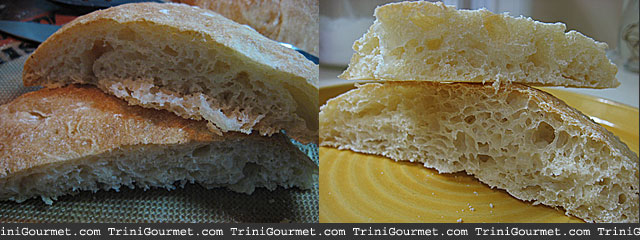Ciabatta Bread (recipe)

This recipe for Ciabatta Bread creates a very light loaf, soft and chewy on the inside with a thin crunchy rustic crust. I originally made it for my mom’s birthday in 2006, before she developed a gluten allergy and it was a huge hit. Since that time it has become one of the most popular recipes here on Trinigourmet, even being linked to by The Fresh Loaf!
Although I have been thrilled by all the attention that my little writeup has gotten through the years it has not been without some controversy. Many readers have expressed confusion and problems with my original instructions. That is why I am now republishing it with greater details around those steps which I think were causing some to have less than desirable results.
Before I proceed I must state that for the best results it is very important that you use bread flour instead of all-purpose. You will get a much better crumb due to the higher gluten content.


Now let’s proceed 🙂
Ciabatta Bread Recipe:
Ingredients:
1/8 teaspoon active dry yeast
2 tablespoons warm water
1/3 cup warm water
1 cup bread flour
1/2 teaspoon active dry yeast
2 tablespoons warm water
1 tsp brown sugar
2/3 cup warm water1 tablespoon 2 tablespoons olive oil (edited in light of this comment 🙂 )
2 cups bread flour
1 1/2 teaspoons salt
Wholewheat flour for dusting
Directions:
1. To Make Sponge: In a small bowl stir together 1/8 teaspoon of the yeast and the warm water and let stand 5 minutes, or until creamy.

2. In a bowl stir together yeast mixture, 1/3 cup of the water, and 1 cup of the bread flour.
3. Stir 4 minutes, then cover bowl with plastic wrap. Let sponge stand at cool room temperature for 24 hours.

After 24 hours
STOP! Before you read on, please note that it is very important that you get these first 3 steps correct. The most common question I get is whether I really meant to add 1/3 cup of water to 1 cup of bread flour! Yes, I did 🙂

At first when you add the water you will get something that looks like this…

rather dry isn’t it?
That’s why the instructions say to stir for four minutes. See how it gradually comes together?


The above can only happen with constant folding. You don’t want a soft or liquid sponge at this point. It will soften considerably as it sits overnight. You want it to hold together.
If at the end it is still a little too dry you can add water by the tablespoon, but again just enough to hold it all together.

4. To Make Bread: In a small bowl stir together yeast, warm water and sugar and let stand 5 minutes, or until creamy.
5. In bowl of a standing electric mixer fitted with dough hook blend together yeast mixture, sponge, water, oil, and flour at low speed until flour is just moistened; add salt and mix until smooth and elastic, about 8 minutes. The dough should be relatively firm at this point and clear the sides of the bowl. If it’s not gradually add more flour (by the 1/4 cup) until it forms as described.

6. Scrape dough into an oiled bowl and cover with plastic wrap.

7. Let dough rise at room temperature until doubled in bulk, about 1 1/2 hours. (Dough will be sticky and full of air bubbles.)

They grow up so fast! 🙂
8. Turn dough out onto a well-floured work surface and cut in half.
9. Transfer each half to a greased baking sheet sprinkled with cornmeal and form into an irregular oval about 9 inches long. Dimple loaves with floured fingers and dust tops with wholewheat flour.

10. Cover loaves with a dampened kitchen towel. Let loaves rise at room temperature until almost doubled in bulk, 1 1/2 to 2 hours.

11. At least 45 minutes before baking ciabatta, put a baking stone on oven rack in lowest position in oven and preheat oven to 425 F (220 degrees C).
12. Bake ciabatta loaves 15-20 minutes, or until pale golden.
13. Cool loaves on a wire rack.
Makes 2 loaves
This post was originally published on November 24, 2006. It has been updated once since then.





